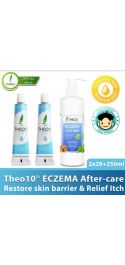
The Different Kinds Of Eczema

Millions of individuals throughout the world suffer from the skin ailment eczema. It is a chronic disorder characterised by dry, red, and itchy skin. There are different kinds of eczema, and each kind has a special set of signs and causes. In this post, we'll examine the various eczema varieties, their distinguishing traits, the age ranges most frequently affected by each type, and their underlying causes.
Atopic Eczema:
The most prevalent type of eczema, known as atopic eczema, frequently affects infants and young children [1]. The inside creases of the elbows and knees are common locations for this type of eczema to develop on the body. Atopic eczema is a chronic, relapsing disorder that is frequently connected to other allergy diseases including asthma and hay fever. Atopic eczema's exact cause is unknown, however it is thought to be associated to an overactive immune system and a deficiency in specific skin proteins.
Contact Dermatitis:
A specific material that triggers an allergic reaction can cause contact dermatitis, a kind of eczema, to develop on the skin. Although this type of eczema can develop at any age, adults are more likely to develop it [2]. Although contact dermatitis can affect any area of the body, it most frequently affects the hands and face. Metals, some chemicals, and cosmetics are frequent causes of contact dermatitis. From red, itchy pimples to blisters and oozing sores, contact dermatitis symptoms can take many different forms.
Nummular Eczema:
Nummular eczema is a form of eczema that is characterized by inflamed skin patches that are shaped like coins and are spherical [3]. This kind of eczema tends to affect the arms and legs in elderly persons and is more prevalent in them. Numbular eczema's root cause is unknown, although it's thought to be connected to dry skin, stress, and an allergic response to some irritants.
Seborrheic Eczema:
Although it can affect persons of different ages, seborrheic eczema is a kind of eczema that is frequently encountered in infants [4]. This kind of eczema can result in red, itchy, and dry skin and typically affects the scalp and face. Although the actual cause of seborrheic eczema is uncertain, a yeast overgrowth on the skin is thought to be a contributing factor.
Biological Causes of Eczema:
Eczema is a complicated illness that is thought to result from a confluence of hereditary and environmental factors. A breakdown in the skin barrier is one of the primary causes of eczema and results in increased moisture loss and susceptibility to irritants and allergens. This may result in an inflammatory reaction in the skin, which brings on the typical eczema symptoms like dryness and itching.
Conclusion:
In conclusion, eczema is a complex skin condition that can have a significant impact on a person's quality of life. There are several types of eczema, each with its own unique set of symptoms and causes. Atopic eczema is the most common type and is often seen in infants and young children. Contact dermatitis is a type of eczema that occurs when the skin comes into contact with a particular substance that causes an allergic reaction. Nummular eczema is characterised by round, coin-shaped patches of irritated skin, and seborrheic eczema is often seen in infants and can affect the scalp and face. While the exact causes of eczema are unknown, it is believed to be related to a malfunction in the skin barrier, which leads to an inflammatory response in the skin. Treatments for eczema often involve managing symptoms and avoiding triggers that can cause outbreaks. Topical creams and ointments can help to reduce inflammation and itching, and in some cases, oral medications may be prescribed.
Overall, understanding the different types of eczema and their causes is essential in managing the condition and improving the quality of life for those who suffer from it.
References:
[1] Bieber, T. (2008). Atopic dermatitis. New England Journal of Medicine, 358(14), 1483-1494.
[2] Zug, K. A., Warshaw, E. M., Fowler Jr, J. F., Maibach, H. I., Belsito, D. L., Pratt, M. D., ... & Zirwas, M. J. (2015). Patch testing with a large series of metal allergens: findings from more than 1,000 patients in one decade at Mayo Clinic. Dermatitis, 26(6), 254-262.
[3] Caproni, M., Antiga, E., Melani, L., & Fabbri, P. (2014). Nummular eczema. Clinics in dermatology, 32(1), 108-118.
[4] Gupta, A. K., Bluhm, R., Cooper, E. A., & Summerbell, R. C. (2004). Seborrheic dermatitis. Dermatology clinics, 22(3), 419-428.
Powered by Mirasvit Magento 2 Extensions
















